Clemson Industrial Engineering had a strong presence at the 2025 IISE Annual Conference and Expo. Our faculty, students, and staff contributed through research presentations, leadership roles, student honors, faculty awards, exhibiting, and department sponsorship. This global gathering of industrial engineering leaders provided a dynamic platform for our community to share ideas, highlight research, and celebrate achievements.
Faculty Awards and Leadership Recognition
Dr. Emily Tucker received two major honors at the conference:
- The IISE Logistics and Supply Chain Division Outstanding Teaching Award, which recognizes excellence in teaching logistics and supply chain courses.
- The IISE Outstanding Regional Faculty Advisor Award, honoring faculty who make significant contributions to their regional IISE student chapter through mentorship, teaching, and support for student-led activities.
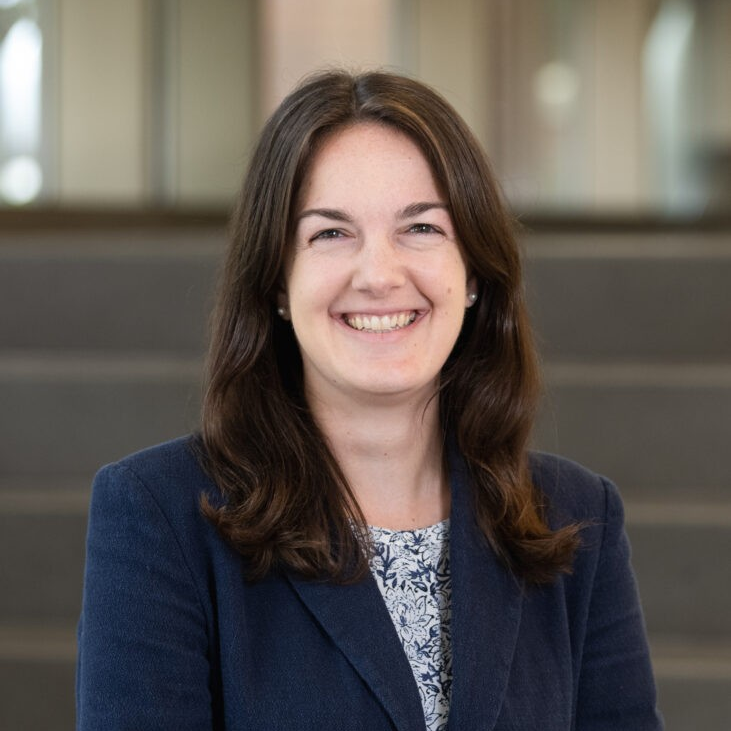
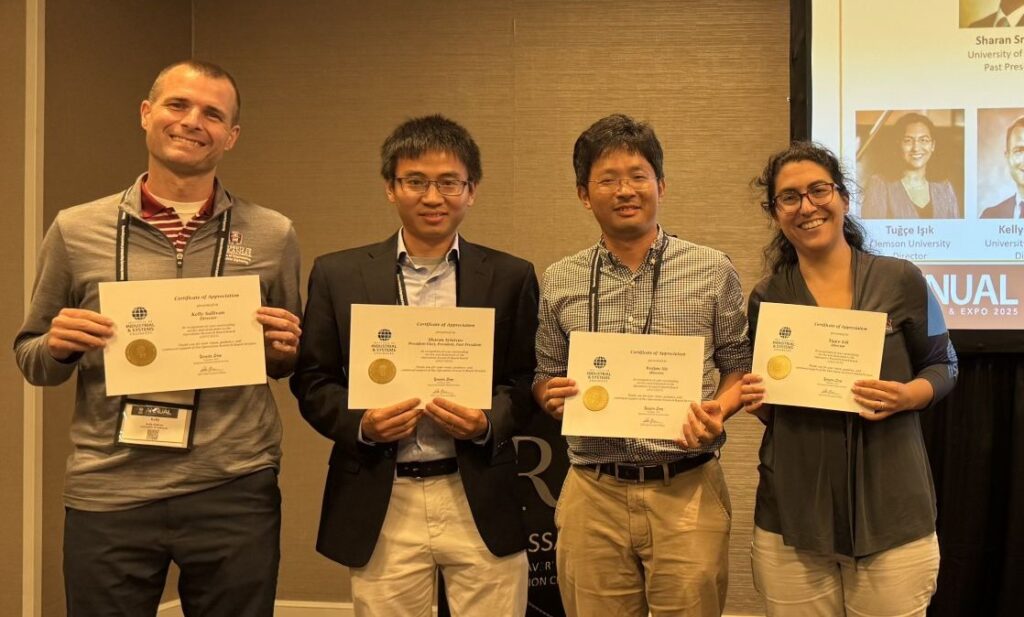
Dr. Yongjia Song and Dr. Tugce Isik were recognized for their leadership within the IISE Operations Research Division. Dr. Song recently completed his term as Division President and now transitions into the role of Past Division President. Dr. Isik was recognized for her service as a Division Director and was elected Division President-Elect. She will serve as Division President during the 2026-2027 term.
Student Honors
Graduate student Dixizi (Krystal) Liu was selected for the prestigious Gilbreth Memorial Fellowship, one of IISE’s most prestigious student honors. The fellowship recognizes outstanding academic achievement, leadership, and dedication to the industrial engineering profession.
Faculty and Student Presentations
Our faculty and students shared their impactful research through oral and poster presentations spanning operations research, public health, disaster logistics, human factors, and more.
Dr. Bill Ferrell presented “Trailer Scheduling at Multi-Door Cross-Docks”, co-authored with graduate students Nikhil Aditya Eti and Alison Gaddy. The team developed a mixed-integer programming model and simulated annealing metaheuristic to optimize trailer arrival and departure times in variable, multi-door cross-dock settings. Their animated solution tool helps practitioners visualize the impact of different scheduling decisions, even without technical modeling expertise. View the conference abstract
Dr. Emily Tucker presented “Optimizing Local Parks for Equity with Decentralized Resident Decision,” co-authored with graduate student Lu Liu. The team developed a model that optimizes the location and size of new parks by considering resident usage patterns, equity, uncertainty, and crowding. Their work aims to support practical decision-making that improves access to green spaces in urban communities. View the conference abstract

Recent Ph.D. graduate Morteza Soltani presented “Replacement Policies for Fixed and Floating Wind Farms”, co-authored with Dr. Jeffrey Kharoufeh and Dr. Amin Khademi. Their model addresses the scheduling of turbine replacements and jackup vessel deployment in offshore wind farms, accounting for he distinct but correlated environmental degradation of fixed and floating turbines. By capturing these dependencies, their approach improves the cost-effectiveness and reliability of maintenance operations. View the conference abstract

Graduate student Farhatul Janan presented “Interdicting Networks to Maximize their Recovery Time: Applications to Disrupting Fentanyl Trafficking”, co-authored with Dr. Thomas Sharkey. Their work models interdiction strategies that delay recovery in disrupted fentanyl trafficking networks using advanced optimization techniques applied to drug networks operating in South Carolina. View the conference abstract
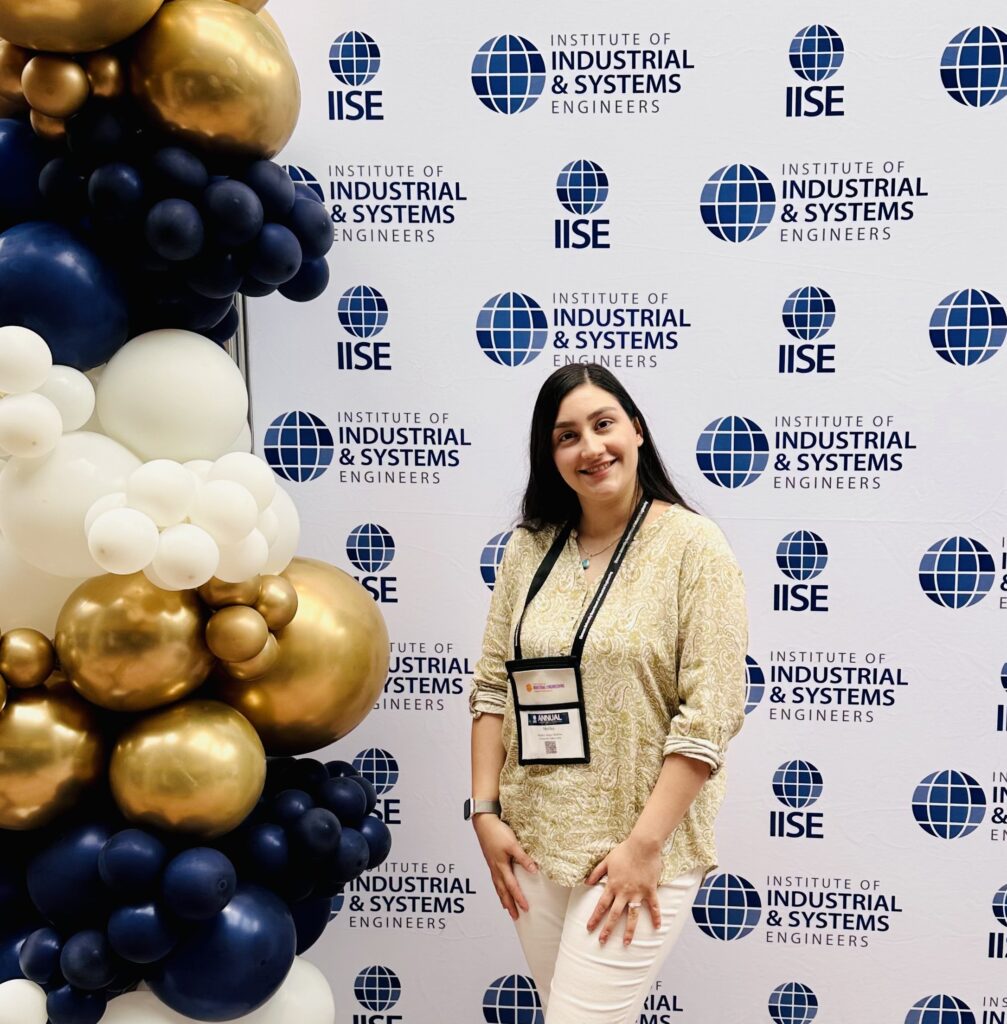
Graduate student Melika Jahan Beikloo presented “Assessing the Distribution of Naloxone Across Communities in South Carolina,” co-authored with Dr. Mary Beth Kurz and Dr. Sharkey. This study uses GIS and regression modeling to examine disparities in naloxone distribution across opioid overdose hotspots in South Carolina. The research highlights how socioeconomic factors affect access and offers policy recommendations for more equitable distribution of this life-saving medication. View the conference abstract
Graduate student Ahmad Kokhahi presented “Path Routing and Task Assignment of Multiple Robots in a Robotic Mobile Fulfillment System,” co-authored with Dr. Kurz. Their work addresses warehouse automation challenges by introducing a collision-aware path planning algorithm, a novel energy-efficient priority rule, and task assignment strategies to reduce travel distance and improve system efficiency. View the conference abstract
Graduate student Daniel Lopes da Silva presented “A Robust Bi-level Network Interdiction Problem with Applications in Human Trafficking Disruption,” co-authored with Dr. Sharkey and Dr. Song. Their research explores interdiction strategies for disrupting trafficking networks by modeling uncertainty in cost and flow parameters. The study offers new insights into robust decision-making in adversarial and data-limited environments. View the conference abstract
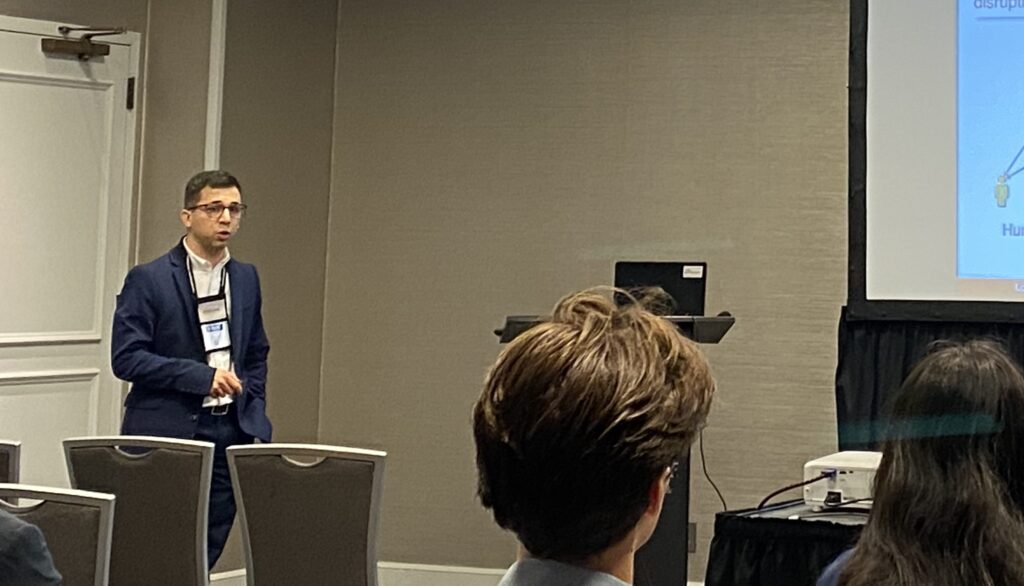
Graduate student Farzad Zeinali presented “Early Prediction of Patient Admission Likelihood in Emergency Departments,” co-authored with Dr. Kevin Taaffe, Dr. Cullen Jackson, and collaborators from Prisma Health. The team developed a decision support tool that uses structured and unstructured patient data to provide early predictions of inpatient demand. Their model helps hospital managers make proactive capacity decisions – reducing emergency department overcrowding and improving care delivery efficiency. View the conference abstract
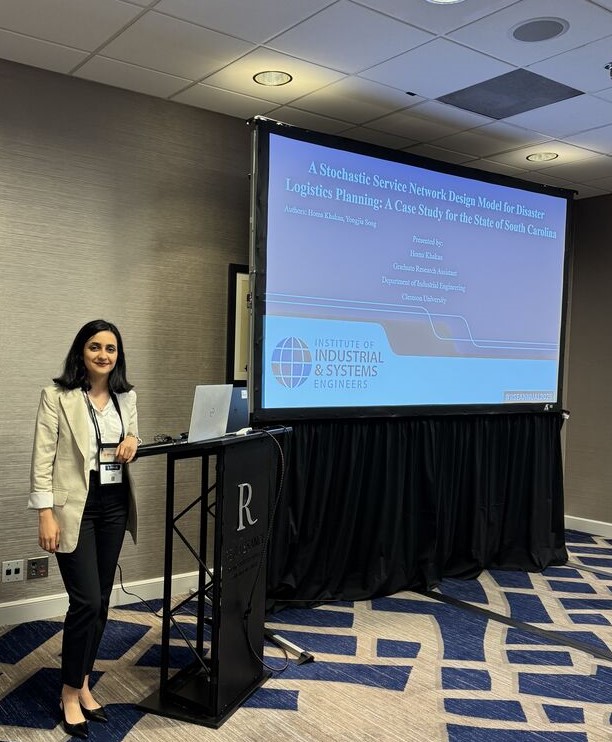
Graduate student Homa Khakan presented “A Stochastic Service Network Design Model for Disaster Logistics Planning: A Case Study for the State of South Carolina,” co-authored with Dr. Yongjia Song. The study models the prepositions of essential relief supplies before a hurricane using a two-stage stochastic programming approach. It incorporates real-time hurricane forecasting, Benders decomposition for computational efficiency, and rolling horizon decision-making to enhance adaptive logistics planning during storm events. View the conference abstract
Graduate student Mina Bahadori presented “Optimizing Healthcare Worker Availability During Infectious Disease Outbreaks with an MDP Model: Simulation-Based Validation and Sensitivity Analysis for Workforce Resilience” co-authored with Dr. Tugce Isik. The research introduces a Markov Decision Process framework for designing staffing policies that reduce infection exposure and improve workforce resilience. The team validated their model through simulation and sensitivity analysis, offering a robust tool for hospital administrators preparing for future health crises. View the conference abstract
Graduate student Sahil Sawant presented “The Effect of Scale of Technology Updates on Workflow Disruptions: A Scoping Review,” co-authored with Dr. Sudeep Hegde and a multidisciplinary team. The review examines how small, moderate, and major health IT changes affect clinical efficiency, workflow stability, and staff adaptation. The study introduces a new categorization framework and highlights strategies to minimize disruption during frequent technology updates in healthcare settings. View the conference abstract

In collaboration with graduate student Pratvusha Joshi, Sahil Sawant also presented “The Impact of Fatigue on Clinical Decision-Making Accuracy in Healthcare Professionals.” This literature review identifies how long shifts, high workloads, and stressful environments contribute to healthcare provider fatigue, reducing decision-making accuracy. The team evaluated fatigue mitigation strategies such as improved shift scheduling and targeted interventions to promote safer clinical judgment and better patient outcomes. View the conference abstract
Graduate student Negin Nazari presented “Designing Provider-Patient Family Conversation Spaces in the Neuro-ICU”, co-authored with Dr. Sudeep Hegde and colleagues from Clemson University and Prisma Health. The project uses the SEIPS 2.0 framework to examine how systemic factors influence end-of-life and care transition conversations in neurological ICUs. By observing meetings, collecting survey and interview data, and analyzing both qualitative and quantitative responses, the team aims to inform a user-centered design framework that better supports coordinated, empathetic, and effective communication between healthcare teams and families. View the conference abstract
Department Engagement
In addition to faculty and student participation in sessions and awards, the department remained highly visible throughout the 2025 IISE Annual Conference and Expo.
Clemson IE was proud to serve as an event sponsor, with the department’s logo featured on all attendee name badges. Faculty, graduate students, and staff also represented the department at the Clemson IE exhibit booth, answering questions, building connections, and showcasing the department’s strengths in research and education.

These efforts reflect the department’s ongoing commitment to national engagement and visibility within the industrial engineering community.
Looking Ahead
We are proud of the many ways our Clemson IE community contributed to this year’s event and look forward to continuing to advance the field of Industrial Engineering through research, leadership, and collaboration. Events like IISE provide invaluable opportunities to connect with peers, highlight impactful work, and further Clemson’s role in shaping the future of industrial engineering.
We’re especially excited to share that Clemson University will host the 2026 IISE Southeast Regional Conference in 2026. We look forward to welcoming students and faculty from across the region to our campus and showcasing what makes Clemson IE a dynamic and inclusive academic community. After all, there’s something in these hills.
